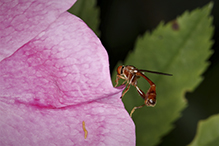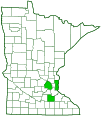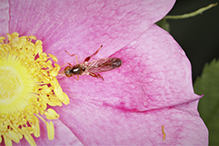Orange-horned hammertail
(Sphegina campanulata)
Conservation • Description • Habitat • Ecology • Distribution • Taxonomy
|
|
||||||||||||||
Description |
Orange-horned hammertail is a small, long, slender, petiolate hoverfly. It is common in eastern North America, present but much less common in the west. It is found in moist deciduous and coniferous forests. Adults are 3 ⁄16″to 5 ⁄16″ (6 to 7 mm) long. The head is strongly concave. The large compound eyes are yellowish-, orangish-, or reddish-brown. They are not covered with hairs. Unlike most syrphid flies, the eyes of the male do not meet at the top of the head. The face is uniformly hairy. The antennae are short, about as long as the face. The large third antenna segment is oval and is partially or entirely orange, giving this fly its common name “orange-horned hammertail.” The long bristle on the antenna (arista) is nearly bare with hairs that are much shorter than the arista is wide. The thorax is entirely yellowish-, orangish-, or reddish-brown. The exoskeletal plate on the upper (dorsal) side has two broad pale longitudinal stripes. The plate between the abdomen and thorax (scutellum) is large and convex. It is colored like the thorax and has marginal bristles. Otherwise, the thorax is entirely bare. There is no subscutellar fringe of hairs. The side plates (metaplura) are joined creating a single plate (postmetacoxal bridge). The postmetacoxal bridge is complete and broad. The fourth plate on the underside is asymmetric, projecting out on the left side. It does not have black spine-like bristles. The small, knob-like structures on each side of the thorax (halteres) are pale. The abdomen is entirely yellowish-, orangish-, or reddish-brown. The second abdominal segment is narrow and elongated, longer than the remaining segments combined, creating a “petiole” between the thorax and the “hammer” at the end of the abdomen. The fourth segment is wider than the third. On the underside of the abdomen, the exoskeletal plate covering the first segment is absent. The ninth segment that supports the copulatory aparatus is very large. The front and middle legs are pale. The third segment (femur) of the hind leg is mostly yellowish-, orangish-, or reddish-brown, whitish at the base. The fourth segment (tibia) of all legs is whitish at the base, darkening toward the tip. On the last part of the leg (tarsus), corresponding to a foot, the last two segments are black. The wings are transparent and are completely covered with microscopic hairs. |
Size |
Total length: 3 ⁄16″to 5 ⁄16″ |
Similar Species |
Habitat |
Moist deciduous and coniferous forests |
Ecology |
Season |
Early May to early August |
Behavior |
|
Life Cycle |
|
Larva Food |
Decaying organic matter |
Adult Food |
|
Distribution |
||
|
Sources Biodiversity occurrence data published by: Minnesota Biodiversity Atlas (accessed through the Minnesota Biodiversity Atlas Portal, bellatlas.umn.edu, 8/19/2025). |
|
| 8/19/2025 | ||
Occurrence |
||
Common |
||
Taxonomy |
|
Order |
|
Suborder |
Brachycera |
Infraorder |
Cyclorrhapha |
Zoosection |
Aschiza |
Family |
Syrphidae (Hover Flies) |
Subfamily |
Eristalinae (drone flies and allies) |
Tribe |
Brachyopini |
Subtribe |
Spheginina |
Genus |
Sphegina (pufftails) |
Subgenus |
|
Subordinate Taxa |
|
|
|
Synonyms |
|
|
|
Common Names |
|
orange-horned hammertail |
|
Glossary
Arista
A large bristle on the upper side of the third segment of the antenna of a fly. Plural: aristae.
Femur
On insects and arachnids, the third, largest, most robust segment of the leg, coming immediately before the tibia. On humans, the thigh bone.
Halteres
In flies: a pair of knob-like structures on the thorax representing hind wings that are used for balance.
Mesonotum
The principal exoskeletal plate on the upper (dorsal) part of the middle segment of the thorax of an insect.
Scutellum
The exoskeletal plate covering the rearward (posterior) part of the middle segment of the thorax in some insects. In Coleoptera, Hemiptera, and Homoptera, the dorsal, often triangular plate behind the pronotum and between the bases of the front wings. In Diptera, the exoskeletal plate between the abdomen and the thorax.
Tarsus
On insects, the last two to five subdivisions of the leg, attached to the tibia; the foot. On spiders, the last segment of the leg. Plural: tarsi.
Tibia
The fourth segment of an insect leg, after the femur and before the tarsus (foot). The fifth segment of a spider leg or palp. Plural: tibiae.
Visitor Photos |
||
Share your photo of this insect. |
||
This button not working for you? |
||
Alfredo Colon |
||
 |
||
MinnesotaSeasons.com Photos |
||
|
||
|
||

Slideshows |
|

Visitor Videos |
||
Share your video of this insect. |
||
This button not working for you? |
||
|
Other Videos |
||
|

Created: 11/4/2018 Last Updated: © MinnesotaSeasons.com. All rights reserved. |



